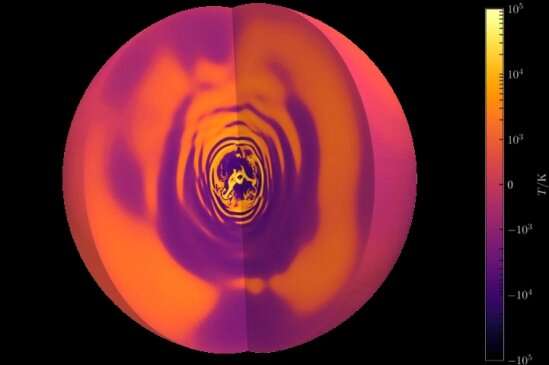
Astronomers commonly refer to massive stars as the chemical factories of the Universe. They generally end their lives in spectacular supernovae, events that forge many of the elements on the periodic table. How elemental nuclei mix within these enormous stars has a major impact on our understanding of their evolution prior to their explosion. It also represents the largest uncertainty for scientists studying their structure and evolution.
A team of astronomers led by May Gade Pedersen, a postdoctoral scholar at UC Santa Barbara's Kavli Institute for Theoretical Physics, have now measured the internal mixing within an ensemble of these stars using observations of waves from their deep interiors. While scientists have used this technique before, this paper marks the first time this has been accomplished for such a large group of stars at once. The results, published in Nature Astronomy, show that the internal mixing is very diverse, with no clear dependence on a star's mass or age.
Stars spend the majority of their lives fusing hydrogen into helium deep in their cores. However, the fusion in particularly massive stars is so concentrated at the center that it leads to a turbulent convective core similar to a pot of boiling water. Convection, along with other processes like rotation, effectively removes helium ash from the core and replaces it with hydrogen from the envelope. This enables the stars to live much longer than otherwise predicted.
Astronomers believe this mixing arises from various physical phenomena, like internal rotation and internal seismic waves in the plasma excited by the convecting core. However, the theory has remained largely unconstrained by observations as it occurs so deep within the star. That said, there is an indirect method of peering into stars: asteroseismology, the study and interpretation of stellar oscillations. The technique has parallels to how seismologists use earthquakes to probe the interior of the Earth.
"The study of stellar oscillations challenges our understanding of stellar structure and evolution," Pedersen said. "They allow us to directly probe the stellar interiors and make comparisons to the predictions from our stellar models."
Pedersen and her collaborators from KU Leuven, the University of Hasselt, and the University of Newcastle have been able to derive the internal mixing for an ensemble of such stars using asteroseismology. This is the first time such a feat has been achieved, and was possible thanks only to a new sample of 26 slowly pulsating B-type stars with identified stellar oscillations from NASA's Kepler mission.
Slowly pulsating B-type stars are between three and eight times more massive than the Sun. They expand and contract on time scales of the order of 12 hours to 5 days, and can change in brightness by up to 5%. Their oscillation modes are particularly sensitive to the conditions near the core, Pedersen explained.
"The internal mixing inside stars has now been measured observationally and turns out to be diverse in our sample, with some stars having almost no mixing while others reveal levels a million times higher," Pedersen said. The diversity turns out to be unrelated to the mass or age of the star. Rather, it's primarily influenced by the internal rotation, though that is not the only factor at play.
"These asteroseismic results finally allow astronomers to improve the theory of internal mixing of massive stars, which has so far remained uncalibrated by observations coming straight from their deep interiors," she added.
The precision at which astronomers can measure stellar oscillations depends directly on how long a star is observed. Increasing the time from one night to one year results in a thousand-fold increase in the measured precision of oscillation frequencies.
"May and her collaborators have really shown the value of asteroseismic observations as probes of the deep interiors of stars in a new and profound way," said KITP Director Lars Bildsten, the Gluck Professor of Theoretical Physics. "I am excited to see what she finds next."
The best data currently available for this comes from the Kepler space mission, which observed the same patch of the sky for four continuous years. The slowly pulsating B-type stars were the highest mass pulsating stars that the telescope observed. While most of these are slightly too small to go supernova, they do share the same internal structure as the more massive stellar chemical factories. Pedersen hopes insights gleaned from studying the B type stars will shed light on the inner workings of their higher mass, O type counterparts.
She plans to use data from NASA's Transiting Exoplanet Survey Satellite (TESS) to study groups of oscillating high-mass stars in OB associations. These groups comprise 10 to more than 100 massive stars between 3 and 120 solar masses. Stars in OB associations are born from the same molecular cloud and share similar ages, she explained. The large sample of stars, and constraint from their common ages, provides exciting new opportunities to study the internal mixing properties of high-mass stars.
In addition to unveiling the processes hidden within stellar interiors, research on stellar oscillations can also provide information on other properties of the stars.
"The stellar oscillations not only allow us to study the internal mixing and rotation of the stars, but also determine other stellar properties such as mass and age," Pedersen explained. "While these are both two of the most fundamental stellar parameters, they are also some of the most difficult to measure."
Explore further
Citation: New research reveals hidden processes at work in the hearts of large stars (2021, May 13) retrieved 13 May 2021 from https://ift.tt/2Rg3Jya
This document is subject to copyright. Apart from any fair dealing for the purpose of private study or research, no part may be reproduced without the written permission. The content is provided for information purposes only.
https://ift.tt/3bpkTQE
Science
No comments:
Post a Comment